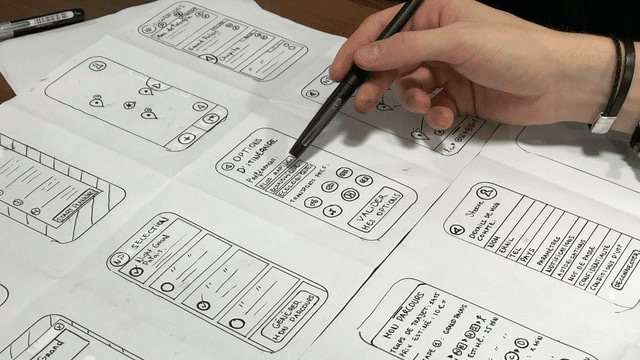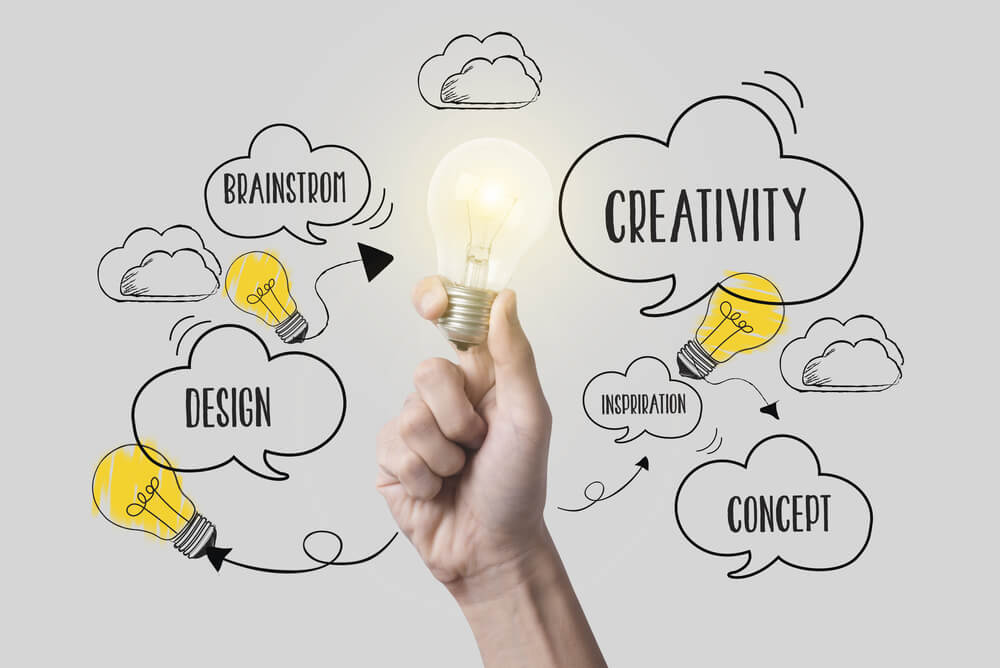Hello everyone, welcome to today’s exhilarating read: What is Design Thinking?!
In this article, we will carefully walk you through all the details of Design Thinking and Design Thinking methodology.
At the end of this post, we promise you will leave with a fuller understanding of what the stages of the design process are, the importance of Design Thinking, and how it can be applied in UX Design.
Here we covered:
- How Design Thinking works
- Benefits of Design Thinking
- What is the Design Thinking process?
- Design Thinking principles
Let’s get started!
Introduction to Design Thinking

The top UX (User Experience) Designers are Design Thinking experts.
They are adept at understanding users and developing apps, websites, and products that can satisfy user needs.
But did you realize that great ideas can have an impact on any industry?
This is because the core idea behind Design Thinking is how to develop in a way that puts the needs of people first.
The ongoing drive to innovate and proffer innovative solutions is nothing new for Designers, design team members, business owners, stakeholders, or any other type of employee.
After all, it’s the formula for advancement and success; the secret ingredient.
The capability for innovation—the power to generate concepts that are both implementable and efficient—gives industries and new products the edge in sectors that are highly competitive.
Design Thinking is a philosophy and a methodology that focuses on finding extremely user-centric solutions to complicated challenges.
In this article, we’ll define Design Thinking in detail, outline the steps involved, and emphasize why it’s important: What are the benefits of Design Thinking, and when is Design Thinking most helpful for real-world problems?
How Does Design Thinking Work?

Design Thinking has long been hailed as the key to creativity and the antidote to complacency.
Despite such well-known success stories, it is a concept that is getting harder and harder to ignore and one that is yet veiled in mystery.
In reality, a variety of disciplines, including engineering, business, and architecture, gave rise to Design Thinking.
Design Thinking is not only applicable to the design industry; it can be used in any industry.
Design Thinking, to put it simply, is a method for coming up with possible solutions to problems that emphasize understanding and addressing people’s needs.
It is a procedure that focuses on providing solutions with the goal of assisting and satisfying the customer or end users.
Design Thinking is employed for service and product development to better satisfy fundamental human needs.
The four main components of Design Thinking, according to IBM, are understanding, exploring, prototyping, and assessing or evaluating:
- Understanding – carefully examining the requirements and preferences of your users
- Exploring – looking into how your product can help users achieve their requirements and desires
- Prototyping – Making a model of a good or service is known as prototyping
- Evaluating – Testing the good or service on actual users who can provide feedback as you refine it is known as evaluation (or repeating the process to improve the product)
Design thinking gained popularity as a result of the development of human-centered design in the 1980s and the establishment of IDEO as a design consultancy in the 1990s.
Design Thinking began to permeate the business world during the beginning of the twenty-first century.
The d.school at Stanford University started teaching Design Thinking as a strategy for social and technical innovation in 2005.
The goal of design thinking is to provide useful outcomes and solutions that are:
- Technically possible: They are capable of being transformed into useful items or procedures
- Economically feasible: The company can afford to put them into practice
- User-desirable: They satisfy a genuine human need
Design Thinking Principles

The Design Thinking process is based on a few key principles.
All of these are reflected in the Design Thinking methodology, which we’ll go over in more detail shortly.
Below, we’ve listed the top five Design Thinking principles:
1. Empathy and User-centricity
Design Thinking is all about coming up with solutions that address user feedback and societal needs.
Since people, not technology, are what drive innovation, putting yourself in your target market’s shoes and developing real empathy for them are crucial steps in the process.
Every design effort, regardless of context, has a social component, and each social innovation will return us to the “human-centric point of view.”
2. Participation and Collaboration
The goal of Design Thinking is to combine a wide range of perspectives and ideas because innovation comes from this!
The use of Design Thinking fosters communication between diverse, multidisciplinary teams that might not typically collaborate.
3. Conceptualization or Ideation
The goal of Design Thinking, which is a framework based on solutions, is to generate as many potential solutions and ideas as you can.
Ideation is both a step in the process and a fundamental Design Thinking principle.
During the ideation phase, participants are encouraged to place more emphasis on the number of ideas than the quality.
Every design is a redesign.
While societal conditions and technology may alter and advance, fundamental human needs never change.
We simply just change how these goals are accomplished or demands are met.
4. Trial-and-error/iteration and Experimentation
Not only must ideas be generated through brainstorming sessions, but they must also be developed into prototypes, tested, and modified in response to user feedback.
Given that Design Thinking is an iterative process, be ready to go back and redo some processes when you identify weaknesses and problems in the preliminary iterations of your suggested solution.
Ambiguity cannot be eliminated or oversimplified; it is an inevitability.
To be able to perceive things differently, you must experiment at the edge of your knowledge and skill.
5. A Tendency for Action-Taking
Design Thinking is a very practical method of problem-solving that prioritizes actions rather than talking.
Design Thinking encourages you to go out and interact with your users directly rather than speculating about what they might desire.
To succeed you must first create concrete prototypes of the answers rather than just discussing them and testing them in actual situations.
Designers can communicate ideas more effectively by giving them a physical embodiment as prototypes.
What is the Design Thinking Process?

The Design Thinking methodology or process is essentially one in which we make a sincere and intense effort to understand the consumer and their experience before we try to solve the problem and proceed into the product ideation and the product design phase.
The Design Thinking approach is progressive and incredibly user-focused.
It describes a sequence of actions that carry out this ideology.
Building user empathy is the first step in the process, which continues through concepts birthing and creating prototypes.
According to the Hasso-Plattner Institute of Design at Stanford, the Design Thinking process can be divided into five steps or phases: empathize, define, ideation sessions, prototype, and test.
It’s crucial to note that these five stages don’t have to happen in any particular sequence or quantity of times.
Instead of viewing Design Thinking as a particular set of sequential stages, these five occurrences should be seen as contributions to the same project that all occur as a result of design thinking.
Let’s investigate each of these in greater depth:
Empathize
The crucial foundation for Design Thinking is empathy.
Understanding the user’s needs, unmet needs, and goals takes up the majority of the first step of the process.
This is actually the fundamental principle of design.
Although it is possible to forecast how a user will respond, Design Thinking has a distinct phase where participants develop an empathy for the issue at hand.
While doing so does require putting yourself in the user’s shoes, it also necessitates talking to specialists in order to comprehend the issue more fully and interacting with actual users.
By taking part in these events, Design Thinkers are encouraged to challenge their preconceptions.
A lot of information about the user and the problem(s) they’re encountering is acquired during this stage.
Ths stage n summary:
- You will interact with and watch your real users
- Provide a clear image of your end-users, their problems, and the requirements and expectations that must be fulfilled
- Carry out polls, interviews, and observation sessions to develop user empathy
To address the issue of employee retention, for instance, you invite every employee to respond to an anonymous survey.
Then, you conduct user interviews with as many workers as you can to learn their opinions on employee retention at the business.
Define the Problem
Design Thinkers use the data gathered throughout this phase’s empathize stage to pinpoint the issue at hand.
It is important to analyze and organize the observations that were made for you and your team to quickly identify the issue.
For instance, team members would sit down and attempt to pinpoint the exact issue if your company detected a sharp decline in sales for a specific product.
Here are some potential questions your team should consider asking:
- Is the new package heavy and difficult to lift?
- Were the packaging’s colors changed?
- Are competitors marketing similar products?
- Was the package’s copy altered?
The identified problem needs to be articulated in a problem statement format, with the user—not you or your company—as the main subject of attention.
Avoid starting your remark with, “We need to make this package easier to lift to earn more sales,” to accomplish this.
Instead, begin your statement with the group of individuals having the issue: “Our company’s customers need to be able to lift this product more readily.”
It serves as a reminder that the solution must also be user-focused by keeping the problem statement that way.
Design thinkers almost immediately go on to the ideation stage of the process after defining the challenge.
Ideate
Design Thinkers may really express their creativity during ideation sessions.
The objective of this phase of free brainstorming and critical thinking is to generate as many ideas and potential solutions as you can.
The second and third stages of the Design Thinking process can happen concurrently, sequentially, or repeatedly.
The most obvious ideas will probably be intuitive or the ones that come to mind first, but Design Thinking fosters distinctive, innovative, and comprehensive solutions.
No concept is too tiny, too big, sophisticated, or simple during this stage.
One of the many tools Design Thinkers can use to organize their creative ideas, think outside the box, and generate new ideas is mind mapping software.
Any and all solutions should be noted right away so that it will be easier to identify which ones stand out from the rest.
You and your team might even realize later on that it might take the fusion of two or more concepts to come up with something brilliant.
Prototype
It’s time to prototype once your design team has come up with a few original ideas.
Experimentation and translating concepts into tangible products are the main focuses of the fourth step in the Design Thinking process.
Design teams can decide whether or not the solutions are worthwhile for further investigation by using wireframing tools to simulate your suggested solution or by building physical prototypes of the proposed solution, whether it be a full product or a part of the product.
The design team can then test these prototypes, but it can be a good idea to incorporate individuals from other divisions or people who won’t necessarily be using the solution in practice.

The goal of this stage is to determine which solution is the greatest fit for the current issue.
Each solution is then developed, tested, and then revised before undergoing additional testing.
Following experimentation, Designers will have a better understanding of the issues users are facing and how easily those issues can be resolved through design or with little effort on the part of the user.
Test
Many times, prototyping can help push some ideas to the background while bringing others to the fore.
The best idea from the prototype stage is put into practice and released into the real world during this stage of Design Thinking.
Design Thinking is not a five-step, one-time process, keep that in mind.
A product must go through numerous, even infinite, iterations in this highly nonlinear process.
The output of the prototype phase is utilized to implement the final step, which is dubbed “Test,” and is then used to help redefine the issue and continue to provide Designers with information about how users will interact with the proposed solution.
Difference Between Problem-Based and Solution-Based Thinking

As the name implies, solution-based thinking is centered on identifying solutions—creating something positive to address a specific issue.
Problem-based thinking, which tends to dwell on constraints and difficulties, is the reverse of this.
Bryan Lawson, a professor of architecture at the University of Sheffield, conducted an empirical study that serves as a good illustration of how these two strategies are put to use.
Lawson was interested in seeing how a team of Scientists and a team of Designers would address a certain issue.
Each group was given the assignment of building one-layer structures out of a set of colored blocks.
There were undefined restrictions about the positioning and relationship of some of the blocks, but the perimeter of the structure had to employ either as many blue bricks or as many red bricks as feasible.
We can think of this as the solution, the desired outcome, or the problem.
In his book, Lawson reported his findings, noting that while Scientists prioritized recognizing the problem (problem-based thinking), Designers prioritized the desire to discover the correct answer (Design Thinking).
Lawson’s results are fundamental to Design Thinking, which is an iterative approach that encourages continuous experimenting until the ideal solution is discovered.
Design Thinking may differ from other problem-solving techniques or design methods in that it doesn’t always adhere to a predetermined pattern.
The five steps of the Design Thinking technique can serve as a guide, but there are no required tasks for each step.
You should consider it more of a general concept than a set of practices or guidelines.
There is a ton of potential for imagination with this.
Is Design Thinking a Linear Process?

You might observe a fairly logical sequence with a predetermined order while looking at these well-specified phases.
Although flexible and fluid, the Design Thinking process loops back on itself and is not linear.

You’ll need to reframe and reconsider what you’ve done in the past with each new discovery that a phase brings—you’ll never be traveling in a straight line!
Why Design Thinking is important

Design Thinking is important because it helps us see how our work affects the bigger picture.
With the thoughtful Design Thinking approach, we can see each other more clearly as people and then design products and services with that in mind.
Design Thinking goes beyond meeting “users’ needs” and takes us back to the basics as we try to meet basic human needs.
This way of looking for solutions not only helps us meet basic human needs but also makes us more creative at work.
Design Thinking doesn’t just solve problems; it also makes services and products that could change the way humans live.
Think about the smartphone, desktop, or laptop you are reading this.
Think about the cup of coffee you might be enjoying.
Before they were made, these things were just ideas.
They were then turned into prototypes and allowed to undergo user testing.
Eventually, they made it to the market and then into your hands.
Design Thinking is important because it pushes us to never settle for the way things are and to always try to get better at what we do.
It also reminds us to never stop dreaming big.
What Skills are Required for Design Thinking?

Design Thinking is an effective skill that all professionals can use.
Regardless of your profession, you may become a more inventive problem-solver by honing your Design Thinking skills.
As a result, you may feel more motivated to encourage innovation inside your company and bring about long-lasting change.
Emotional Intelligence
Anyone who is engaged in Design Thinking needs to possess strong emotional intelligence.
This is due to the fact that Design Thinking demands the practitioner to have a deep, personal understanding of the end user’s goals, dreams, and challenges.
None of the other stages of the Design Thinking process can be finished without the ability to empathize.
Consensus Building Skill
It’s critical for all team members to agree on the difficulty being addressed in the early stages of the Design Thinking process.
What purpose does the solution serve?
Who is the ideal consumer or client for the product or service?
What do you mean by success?
Without consensus on these issues, the process could stall and fail altogether.
Developing your consensus-building abilities can help you keep your project going forward.
User Research Skill
Understanding the end-user of a service or product in order to better understand the issues they confront, their needs, and the particular standards they will use to choose a solution is known as user research.
You can start to understand your end-user through user research, which also helps you identify and frame the problem and generate ideas.
Brainstorming Skill
Your main responsibility during the ideation stage of the Design Thinking process is to use the knowledge you’ve gained through user research, journey mapping, and empathizing to come up with potential solutions to your end user’s problem.
It’s essential to have the competence and creativity to freely and creatively brainstorm new solutions.
What are the Benefits of Design Thinking?

Using a Design Thinking method has several advantages, whether it is in an academic, professional, personal, or social setting.
Design Thinking, above all, encourages originality and creativity.
As human beings, we rely on our knowledge and experiences to guide our decisions.
We develop patterns and habits that, though beneficial in some circumstances, might restrict our perspective when it comes to problem-solving.
Design Thinking enables us to take off our blinders and think about different solutions rather than repeating the same tried-and-true procedures.
The entire procedure encourages questioning presumptions and investigating alternative ideas and strategies.
Design Thinking is frequently referred to as the productive middle ground of problem-solving because it employs a combination of creative thinking and analytical thinking, rather than merely relying on logic, reason, or analytics.
The reality that Design Thinking prioritizes people is another outstanding advantage.
Emphasizing empathy so significantly pushes organizations and companies to think about the actual people who use their services and goods, making them considerably more likely to succeed in developing memorable customer experiences.
For the consumer, this translates into better, more practical items that genuinely enhance our lives.
This translates for businesses into content customers and a stronger bottom line.
Utilizing design thinking, we can solve “wicked” problems.
The types of issues that design thinking tackles are what make it special. It is not only routine challenges, everyday issues with tried-and-true answers that need to be tackled through Design Thinking.
Design Thinking deals with difficult, “wicked,” problems—the kind that defies traditional strategies and techniques.
Wicked problems abound, from global problems like climate change and poverty to issues that touch practically every industry, like attaining sustainable growth, managing change, or keeping your competitive edge.
Design Thinking is a practical strategy that may be applied to solve even the most difficult issues.
It encourages imagination, user-centricity, innovation, and creative problem-solving.
Design Thinking in UX Design (Application of Design Thinking)

If UX Design interests you, you might be curious about how Design Thinking relates to this discipline.
UX Designers can use the framework of Design Thinking to approach challenging, vast, or even largely unexplored topics in product development.
You may have noticed that the Design Thinking paradigm discussed previously and UX work already share a lot of similarities.
For instance, user experience Designers start with market and user research before moving on to information architecture (structuring and organizing content).
Following that, they’ll produce user flows, wireframes, and prototypes that they’ll employ for user testing.
A skilled UX Designer approaches their work with a design thinking attitude because the practice is more of a way of thinking than it is a collection of actions.
This enables them to maintain their attention on people and interact with them in an empathic way.
Conclusion

You play a crucial part in determining the products and experiences that your business brings to the market as a Designer.
By incorporating Design Thinking into your process, you can ensure that your goods are not only appealing to customers but also financially and resource-viable for your organization.
One of the best ways to improve your skills in Design Thinking is to use them on the job, but that takes time.
Another choice is to finish a Design Thinking course or workshop that is offered online.
If you want to quickly develop your Design Thinking abilities or would benefit from a more structured learning setting, this is a very effective route.
FAQs

What are the 5 Stages of Design Thinking?
Design thinking is in fact a non-linear, continuous technique that enables teams to develop and test new solutions while also challenging presumptions and reframing difficulties.
Five steps or phases can be used to summarize the design thinking process: empathize, define, ideate, prototype, and test.
What is Thinking Graphic?
The technique of thinking through visual processing is known as graphic thinking.
It is also referred to as spatial learning or visual thinking.
While graphic thinking is a set of tools that can help simplify complex solutions or ideas by visualizing them, design thinking is a strategy for problem-solving.
What is a Design Thinking Approach?
A process called “Design Thinking” offers a problem-based approach to problem-solving.
Since it helps to comprehend the human needs involved, reframe the situation in ways that are human-centric, and generate various ideas, it is incredibly helpful when used to address complicated challenges that are unknown or ill-defined.
What is Design Thinking Used for?
Design Thinking is a method of problem-solving that puts the requirements of the customer first.
It relies on empathetically observing how people interact with their surroundings and uses a hands-on, iterative process to develop creative solutions.
What is One of the Tools Associated with Design Thinking?
Design Thinking tools like empathy maps encourage customer identification by assisting groups in creating a deep, shared understanding of others.
They aid teams in imagining the thoughts, emotions, sounds, and sights of a particular persona while they use the product.
What is the Best Example of Design Thinking?
Netflix is a perfect example of Design Thinking since it applied the methodology throughout its development to identify the requirements and wants of its customers before adapting its business strategy to satisfy those needs.









